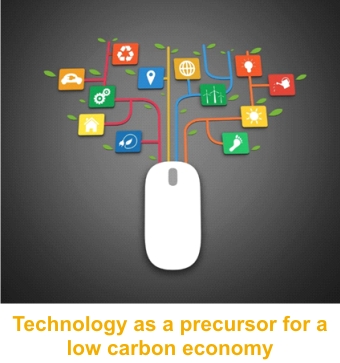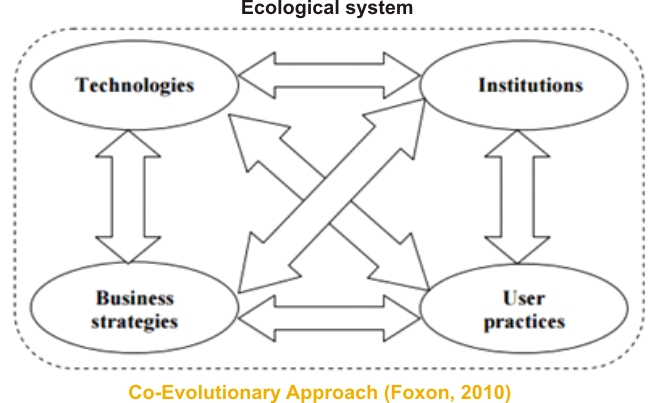|
Co-Evolutionary Approach
to
Since
the first major international conference was convened to address issues
concerning the environmental and sustainable development in Stockholm,
Sweden, 1972, titled, ‘United Nations Conference on the Human
Environment, the world has come a long way in understanding climate
change and its consequences, global consumption patterns and the
bio-capacity of its natural resources etc. The Stern Review on the
Economics of Climate Change, a report which was undertaken for the
Government of the United Kingdom, argued that the cost of transitioning
to a low carbon economy would be much less than the costs and risks of
the impact of unmitigated climate change if high technologies and
practices were to continue to dominate systems for energy provision
(Stern, 2007).
Thus, while there is theoretical and policy interest to transition to a low carbon economy, diffusion and adoption of technologies have seen slower progress. A recent concept that has been investigated in the light of understanding innovative technologies and practices that can lead to a low carbon economy, is that of a ‘co-evolutionary’ approach to understanding technological change. This approach claims the development of technologies both influences and is influenced by the social, economic and cultural setting in which they are developed (Rip & Kemp, 1998). Understanding the Co-Evolutionary Approach towards a Low-Carbon Economy The transition to a sustainable low carbon economy will require innovation and deployment of a range of low carbon technologies for delivering energy and other services for individuals, communities and businesses, and broader change in the mix of industries for maintaining and widening economic prosperity whilst remaining within ecological limits. While this may be true, it is important to analyse the causal influences between key evolving systems of technologies, institutions and business strategies in relation to lock-in of high carbon energy systems. A key approach to assessing this ‘transition’ is that of a socio-technical framework which is based on the interactions between three levels: technological niche, socio-technical regimes and landscapes (Geels, 2002). The landscape (macro) level represents the broader political, social and cultural values and institutions that form the deep structural relationships of a society and only change slowly. The socio-technical regime (meso level) reflects the prevailing set of routines or practices used by actors, which create and reinforce a particular technological system, which includes the kind of engineering processes used, production process technologies, product characteristics, skills and procedures etc. (Rip & Kemp, 1998), all of which are embedded in the institutions and infrastructure. Lastly at the micro-level are the technological niches, which are spaces that are to a large extent isolated from the normal selection processes in the regime, and function as specialised or exclusive sectors or market locations. These technological niches provide places for learning processes to occur, and space to build up the social networks that support innovations, such as supply chains and user-producer relationships (Foxon, 2010). Thus, the transition pathways arise through the dynamic interaction of technological and social factors at these different levels. This approach is based on the belief that evolutionary theories of economic change go against the neo-classical economic assumptions of perfect rationality of actors and quasi-equilibrium analysis. This approach argues that actors have bounded rationality and that industrial change occurs through ‘creative destruction’ (Schumpeter, 1942). This argument implies that both individuals and firms, do not at any given point have the ability to gather or process information relevant to economic decisions. Thus in such a case they act under a certain level of uncertainty within the given institutional context. Therefore, rather than being profit-maximising, firms follow routines of profit or performance and are only changed when outcomes are no longer satisfactory, due to internal or external changes (Nelson & Winter, 1982). This in turn is related to the technology support that is given. Freeman and Perez (1988) argued that the widespread deployment of new technologies leads to structural crises of adjustment, as new institutions and industrial structures have to be developed which are appropriate to these technologies. One aspect that firms and individuals are unable to grapple with in the first stage of the adoption of a technology is the social context of the use of these technologies. The social context includes both the development of other activities needed to support the use of the technology, e.g. training of skilled persons to install and repair it, and also the development of shared meanings about the way in which a technology is used, e.g., primarily for business, recreational or social purposes. In the case of new innovative technologies, it is through the development of new institutional frameworks, and partly through the development of user practices, related to the use of the new technology that is important.
Linking Greener Technologies to the
Co-Evolutionary Approach Given the above understanding of the co-evolutionary approach towards understanding ecological economics, the primary work of the Development Alternatives Group has been to look at the co-evolutionary approach to greener technologies right from the innovation stage (conceptualisation of the idea) right up to the influence stage (influencing governmental policy). Case examples of such work is that of the Limestone Calcined Clay Cement (LC3), a cement that is estimated to reduce the use of limestone by 50% and replace the use of limestone with waste china clay from mines. Similarly, in the case of fly-ash bricks, it is not just the case of availability of fly-ash for brick-making, but rather the landscape i.e. fly ash-notification 396 (E) 2015 and socio-technical regime i.e. fly-ash brick making units, production processes, skills, ready market etc. play an important role in the adoption and the scale at which such production systems are adopted. ■ References: • Foxon, T. J. (2010, August). A oevolutionary framework for analysing a transition to a sustainable low carbon economy. Sustainability Research Institute(22). • Geels, F. (2002). Technological transitions as evolutionary reconfiguration processes: a multi-level perspective and a case-study. Research Policy, 1257-1274. • Nelson, R. R., & Winter, S. (1982). An evolutionary theory of economic change. Cambridge, Massachusetts: Harvard University Press. • Rip, A., & Kemp, R. (1998). Technological change. (S. R. Malone, Ed.) Human Choices and Climate Change, 2. • Schumpeter, J. (1942). Capitalism, Socialism and Democracy. New York: Harper and Brothers. • Stern, N. (2007). The Economics of Climate Change: The Stern Review . Cambridge: Cambridge University Press.
Pratibha Caleb
|

